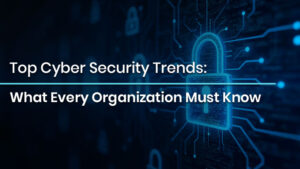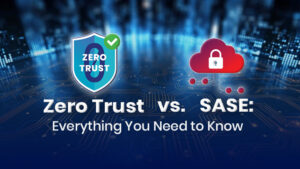
Azure Certifications – Validate Your Azure Cloud Skills
Azure Certifications – Validate Your Azure Cloud Skills Introduction Cloud computing has transformed the business landscape, providing scalability, flexibility, and affordability in a way
Limited-Time Offer! Get an exclusive 40% OFF on IPSpecialist Premium Monthly & Annual Plans. Use Promo Code: UPSKILLNOW at checkout.

Azure Certifications – Validate Your Azure Cloud Skills Introduction Cloud computing has transformed the business landscape, providing scalability, flexibility, and affordability in a way

Top Cyber Security Trends: What Every Organization Must Know Introduction In an era marked by digital transformation, remote workforces, and rapidly evolving threat landscapes,

Zero Trust vs. SASE: Everything You Need to Know Introduction As the cyber world continues to change, companies need to look beyond conventional security
Table of Contents
In the modern digital landscape, cybersecurity is no longer just an IT concern, it’s a critical component of a company’s overall risk management strategy. With cyberattacks growing in frequency, sophistication, and impact, businesses must be proactive in safeguarding their data, systems, and reputation. A strong cybersecurity strategy not only prevents potential breaches but also ensures regulatory compliance and maintains customer trust. This blog will guide you through the key components of building a comprehensive cybersecurity strategy that aligns with your business goals and keeps your digital assets secure.
At IPSpecialist Services, we understand that cybersecurity is a journey, not a one-time fix. Our end-to-end Managed Security Services are designed to help businesses like yours stay one step ahead of cybercriminals, with proactive defenses, expert support, and scalable solutions.
You need to understand first, what a modern organization faces daily:
A strong cybersecurity strategy helps address these issues holistically, not reactively.
1. Review Your Current Cybersecurity Posture
Before instituting a cybersecurity plan, you need to assess your current security controls. This starts with a risk analysis that determines your most important assets, like customer information, intellectual property, and financial information, and how protected they are today. Knowing your weaknesses, past breaches, and compliance vulnerabilities will enable you to address the most pressing security enhancements. Ongoing audits should be performed to update your assessments as your company changes.
2. Create Good Cybersecurity Policies
Clearly defined policies make up the backbone of your cybersecurity system. These must include a broad array of practices such as acceptable use policies, password standards, remote work security practices, data handling guidelines, and incident response plans. Your policies should be adapted to your industry, firm size, and exposure to risk. It’s just as critical that these guidelines are made readily available and updated frequently enough to incorporate emerging threats and changing regulations.
3. Train and Educate Your Employees
Human mistake is the number one reason for security incidents. The most sophisticated security software can’t save your business if staff doesn’t use best practices. All staff, not only the IT team, should receive regular cybersecurity training. This involves identifying phishing attacks, staying away from dubious downloads, and using secure login protocols. Running simulated attacks and refreshers ensures good habits stick and security stays front-of-mind.
4. Adopt Layered Security Controls
A solid cybersecurity practice needs to have several layers of control to combat numerous threat vectors. This entails the installation of firewalls, intrusion detection systems, anti-malware software, and email filtering solutions. Segmenting the network can also deny lateral movement across systems if an intruder penetrates a single entry point. Furthermore, using multi-factor authentication (MFA) greatly secures user identities and minimizes the chance of credentials being stolen.
5. Secure Endpoints and Mobile Devices
As more companies adopt remote work and BYOD (Bring Your Own Device) policies, endpoints like laptops, smartphones, and tablets have also emerged as high-value targets for cyberattacks. Using endpoint detection and response (EDR) tools ensures that it monitors device behavior and identifies anomalies in a timely manner. Mobile device management (MDM) software enables the IT department to enforce security configurations, remotely erase lost devices, and maintain uniform security standards across all the endpoints.
6. Secure Cloud Environments
Most companies now depend on cloud services for storage, collaboration, and application hosting. Although cloud providers have built-in security, it’s still your job to set and manage those settings effectively. Encrypt sensitive information at rest and in transit, track user activity, and implement role-based access controls to ensure that only authorized personnel have access. Meet with your cloud vendor to learn about shared responsibility models and compliance implications.
7. Proactively Monitor and Respond to Threats
Ongoing monitoring of systems and networks is critical for early detection of threats. Security Information and Event Management (SIEM) solutions can gather and analyze logs from throughout your infrastructure, issuing warnings when abnormal activity is recognized. A clearly defined incident response plan means your staff will know precisely what to do when an attack is launched, reducing downtime, data loss, and reputational damage. The plan should provide well-established roles, communications procedures, and procedures for post-incident analysis.
8. Update and Patch Systems Regularly
Old systems and software are frequently targeted through known vulnerabilities. To seal these security loopholes, implement a regular patch management process involving regular updates of firmware, applications, and operating systems. Automating the updates where feasible can eliminate manual intervention and provide faster deployment of essential security patches. Do not forget to monitor third-party applications as well, which often act as a point of entry for attackers.
9. Be Compliant with Legal and Industry Requirements
Regulatory compliance with GDPR, HIPAA, PCI-DSS, and others requires specific data protection practices. Noncompliance can lead to serious penalties, legal action, and damage to reputation. Your cybersecurity plan needs to address procedures for documenting compliance activities, regular audits, and being up to date on regulatory changes. Consulting compliance specialists or attorneys may guarantee that your cybersecurity initiatives are effective as well as compliant with the law.
10. Test and Refine Your Strategy Ongoing
Cybersecurity is not a project, it is an ongoing process. Test your defenses regularly with vulnerability assessments, penetration testing, and simulated incident exercises. These exercises identify security gaps and give you the opportunity to fix them before the bad guys do. Keeping up with new technologies, new threats, and industry best practices will enable you to evolve your strategy and keep ahead of changing risk.
Developing a strong cybersecurity plan takes careful, multi-faceted thinking that changes over time with your business and the threat environment. By identifying your weaknesses, imposing policies, training employees, and utilizing the correct technologies, you can establish a strong defense that protects your digital assets. Cybersecurity is more than an IT task, it’s a business imperative that needs executive oversight and continuing investment. It makes sense to act proactively today to protect your organization against expensive disruptions in the future.
1. Why is a cybersecurity strategy important to small businesses?
Small businesses are more commonly attacked by cybercriminals because they tend to have less robust defenses. A robust cybersecurity strategy secures sensitive information, maintains regulatory compliance, and establishes customer confidence, crucial for long-term development and reputation management.
2. How frequently should a company re-update its cybersecurity strategy?
A firm should periodically review and revise its cybersecurity plan at least once a year or whenever significant changes happen in technology, business processes, or the threat environment. These updates should be based on frequent audits, testing, and reviews of incidents.
3. What are the most prevalent cybersecurity threats today?
Some of the most widespread threats are DDoS attacks, zero-day vulnerabilities, ransomware, phishing attacks, and insider threats. Being updated with changing threats and continuous employee training are essential for effective mitigation against these risks.
© 2025 All rights reserved | Privacy Policy | Terms and Conditions | Sitemap | Cookie Policy




